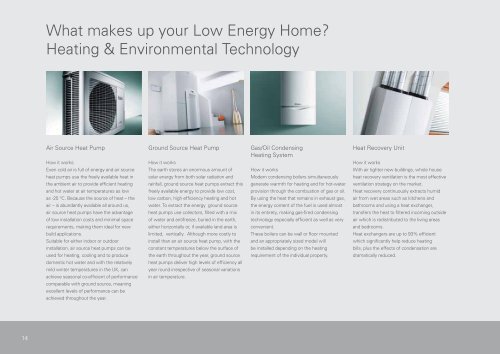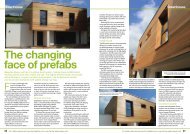HANSE HAUS Buyer Guide - Ecobuild
HANSE HAUS Buyer Guide - Ecobuild
HANSE HAUS Buyer Guide - Ecobuild
You also want an ePaper? Increase the reach of your titles
YUMPU automatically turns print PDFs into web optimized ePapers that Google loves.
What makes up your Low Energy Home<br />
Heating & Environmental Technology<br />
Air Source Heat Pump<br />
How it works<br />
Even cold air is full of energy and air source<br />
heat pumps use the freely available heat in<br />
the ambient air to provide efficient heating<br />
and hot water at air temperatures as low<br />
as -25 °C. Because the source of heat – the<br />
air – is abundantly available all around us,<br />
air source heat pumps have the advantage<br />
of low installation costs and minimal space<br />
requirements, making them ideal for new<br />
build applications.<br />
Suitable for either indoor or outdoor<br />
installation, air source heat pumps can be<br />
used for heating, cooling and to produce<br />
domestic hot water and with the relatively<br />
mild winter temperatures in the UK, can<br />
achieve seasonal co-efficient of performance<br />
comparable with ground source, meaning<br />
excellent levels of performance can be<br />
achieved throughout the year.<br />
Ground Source Heat Pump<br />
How it works<br />
The earth stores an enormous amount of<br />
solar energy from both solar radiation and<br />
rainfall, ground source heat pumps extract this<br />
freely available energy to provide low cost,<br />
low carbon, high efficiency heating and hot<br />
water. To extract the energy ground source<br />
heat pumps use collectors, filled with a mix<br />
of water and antifreeze, buried in the earth,<br />
either horizontally or, if available land area is<br />
limited, vertically. Although more costly to<br />
install than an air source heat pump, with the<br />
constant temperatures below the surface of<br />
the earth throughout the year, ground source<br />
heat pumps deliver high levels of efficiency all<br />
year round irrespective of seasonal variations<br />
in air temperature.<br />
Gas/Oil Condensing<br />
Heating System<br />
How it works<br />
Modern condensing boilers simultaneously<br />
generate warmth for heating and for hot-water<br />
provision through the combustion of gas or oil.<br />
By using the heat that remains in exhaust gas,<br />
the energy content of the fuel is used almost<br />
in its entirety, making gas-fired condensing<br />
technology especially efficient as well as very<br />
convenient.<br />
These boilers can be wall or floor mounted<br />
and an appropriately sized model will<br />
be installed depending on the heating<br />
requirement of the individual property.<br />
Heat Recovery Unit<br />
How it works<br />
With air tighter new buildings, whole house<br />
heat recovery ventilation is the most effective<br />
ventilation strategy on the market.<br />
Heat recovery continuously extracts humid<br />
air from wet areas such as kitchens and<br />
bathrooms and using a heat exchanger,<br />
transfers the heat to filtered incoming outside<br />
air which is redistributed to the living areas<br />
and bedrooms.<br />
Heat exchangers are up to 93% efficient<br />
which significantly help reduce heating<br />
bills, plus the effects of condensation are<br />
dramatically reduced.<br />
14



![more [PDF] - Hanse Haus](https://img.yumpu.com/49967377/1/190x248/more-pdf-hanse-haus.jpg?quality=85)
![more [PDF] - Hanse Haus](https://img.yumpu.com/36721022/1/190x247/more-pdf-hanse-haus.jpg?quality=85)

![more [PDF] - Hanse Haus](https://img.yumpu.com/36721004/1/190x248/more-pdf-hanse-haus.jpg?quality=85)
![more [PDF] - Hanse Haus](https://img.yumpu.com/9460010/1/190x248/more-pdf-hanse-haus.jpg?quality=85)
